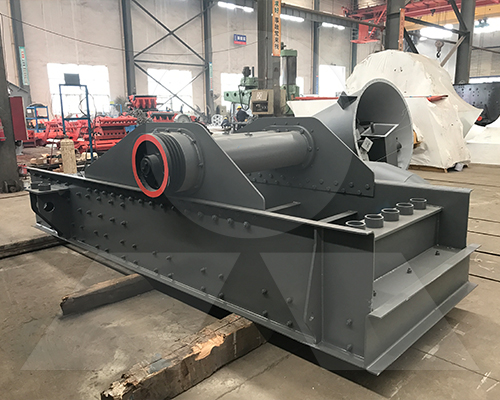High-Capacity Stone Vibrating Feeder: Enhancing Efficiency in Material Handling
In industries such as mining, construction, and aggregate processing, the efficient handling of raw materials is crucial. High-capacity stone vibrating feeders play a vital role in these processes, ensuring a consistent and controlled flow of materials to various types of crushing and screening equipment. This article explores the benefits, applications, and best practices for using high-capacity stone vibrating feeders to enhance material handling efficiency.
Introduction to Vibrating Feeders
Vibrating feeders are mechanical devices designed to transport bulk materials by using vibratory motion. They consist of a vibrating tray or chute that moves materials along with controlled vibrations. High-capacity stone vibrating feeders are specifically engineered to handle large volumes of heavy, abrasive materials such as rock, ore, and gravel, making them indispensable in many industrial applications.

Benefits of High-Capacity Stone Vibrating Feeders
- Consistent Material Flow: High-capacity vibrating feeders ensure a steady and uniform flow of materials to downstream processing equipment. This consistency is critical for maintaining optimal production rates and avoiding equipment overloading.
- Improved Efficiency: By regulating the feed rate, vibrating feeders help to maximize the efficiency of crushers, screens, and other processing equipment. This results in higher throughput and better overall productivity.
- Durability and Reliability: Designed to withstand harsh conditions, high-capacity stone vibrating feeders are built from robust materials and feature durable components. This ensures long-term reliability and reduces the need for frequent maintenance.
- Versatility: These feeders can handle a wide range of materials, from fine particles to large boulders. Their versatility makes them suitable for various applications, including mining, quarrying, and construction.
- Reduced Operating Costs: By optimizing the feeding process, vibrating feeders help to reduce energy consumption and wear on downstream equipment. This translates into lower operating costs and increased profitability.
Applications of High-Capacity Stone Vibrating Feeders
- Mining Industry: In mining operations, vibrating feeders are used to transport extracted materials from the mine site to processing facilities. They play a crucial role in managing the flow of ore, coal, and other minerals.
- Quarrying: In quarries, vibrating feeders are employed to move raw stone to crushers and screens. This ensures a continuous supply of material for processing and helps to maintain efficient production schedules.
- Aggregate Processing: For the production of concrete and asphalt, vibrating feeders are used to feed raw aggregates into crushers, screens, and mixers. Their ability to handle high volumes of material makes them essential in large-scale aggregate plants.
- Construction Sites: On construction sites, vibrating feeders are used to transport materials such as sand, gravel, and crushed stone. Their portability and high capacity make them ideal for use in large construction projects.
Best Practices for Using High-Capacity Stone Vibrating Feeders
- Proper Installation: Ensure that the vibrating feeder is installed correctly and securely. This includes aligning the feeder with downstream equipment and verifying that all components are properly connected and functioning.
- Regular Maintenance: Conduct routine inspections and maintenance to keep the feeder in optimal condition. This includes checking for wear and tear, ensuring that all parts are properly lubricated, and replacing any damaged components promptly.
- Adjustable Settings: Utilize the adjustable settings on the vibrating feeder to optimize material flow rates. This allows for fine-tuning of the feed rate to match the requirements of downstream equipment and varying material characteristics.
- Training Operators: Provide comprehensive training for operators on the proper use and maintenance of the vibrating feeder. Well-trained operators can identify potential issues early and ensure the feeder operates at peak efficiency.
- Monitoring Performance: Continuously monitor the performance of the vibrating feeder and make necessary adjustments to maintain consistent material flow. Implementing sensors and automated controls can help to achieve this.
Conclusion
High-capacity stone vibrating feeders are essential components in material handling systems for industries such as mining, quarrying, and construction. Their ability to provide a consistent and controlled flow of materials enhances the efficiency and productivity of downstream processing equipment. By following best practices for installation, maintenance, and operation, businesses can maximize the benefits of these powerful machines, ensuring reliable and cost-effective material handling in their operations.
- > Basic Troubleshooting of Jaw Crusher Issues
- > Vibrating Feeders in Chile: Enhancing Material Handling Efficiency in Mining and Construction
- > Applications of Mobile Dolomite Cone Crusher in Malaysia: A Comprehensive Overview
- > Comparison of Crushing Equipment Selection for Granite and Basalt: Key Differences and Considerations
- > Gravel Impact Crusher for Concrete Aggregates: Enhancing Construction Efficiency
- > High-Demand Mining Ball Mill Widely Used in Cement Production Lines
- > The Popularity of Chinese Spring Cone Crushers in Africa
- > Cone Crushers for Sand Production: Enhancing Efficiency and Quality


Online




Message
